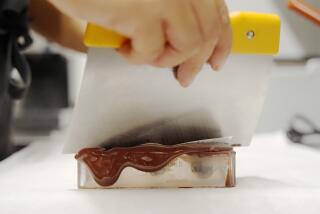PURSUING A TASTE FOR LESS SALT
- Share via
To Danny Kaye he was royalty--”the good kind, the kind that is earned, not inherited.” Julia Child remembered his kindness when she was nothing but an unknown, awe-struck cookbook writer meeting him for the first time. And Marion Cunningham said that he had changed her life. She recalled telling him once that “I don’t think there is anything I can ever do to repay you for all that you’ve done for me.” “You know,” she added, “he was a very honest man. He thought about what I’d said, and then he replied, ‘You’re right, there isn’t.’ ”
That royal, kind, honest man was, of course, James Beard, who was much missed at the American Institute of Wine and Food’s Conference on Gastronomy, held last week in Santa Barbara. He was the major topic of discussion, closely followed by health and nutrition, a subject currently causing a lot of consternation in gastronomic circles. “Can gastronomy and nutrition coexist at the same table?” was one of the weightier panel discussions of the conference. The answer seemed to be no; the nutritionists couldn’t even agree on whether cholesterol is good or bad for you.
Why is it that being good always seems so dreary? The nutritionists on hand spent so long scolding us about the way that we eat that I, for one, felt like running right out for a big steak. To make things worse, the panel was followed by a meal prepared by Michel Stroot, chef at the oh-so-health-conscious Golden Door. The meal was made out of grains and vegetables and all those things the nutritionists keep urging upon us. It was made entirely without salt, and almost without calories; the three courses added up to only 400. But despite my natural reluctance to eat things with names like “tofu apricot creme,” I thought it was the best meal I ate in a week filled with fancy food by big-name chefs.
We started with a salad of arugula, sprouts, greens and sunflower seeds, covered with a lemon-thyme dressing. It was as delicious as it was lovely. Then came little pieces of chicken breast in a powerful peanut sauce; the good green smell of lime came wafting invitingly up from the plate. The sauce, a tantalizing mixture of peanuts, ginger, garlic and lime, was so refreshing that the absence of salt was virtually undetectable. The pilaf, made from brown rice and corn, was dotted with piquant little bits of chile that added a refreshing bite. And even that tofu apricot creme, a pretty mousse in a glass filled with blueberries, strawberries and cassis, was irresistible. This food was so delicious that I kept having the sneaking suspicion that the chef was cheating; how could something so good be so good for you?
Have I been missing something? Stroot’s food so impressed me that I decided to investigate one of our foremost local practitioners of cuisine naturel. Panache, a restaurant tucked into the lobby of a giant office building in Santa Monica, uses no salt in the preparation of its food, and five of the dishes on the menu meet the American Heart Assn. dietary guidelines.
It’s a cozy place that strives for a turn-of-the-century look. There are low lights, patterned wallpaper and overstuffed chairs with such high backs that they make virtual booths out of the tables. It has a really friendly feeling, enhanced by the chef, who wanders endearingly about the dining room inquiring, “Is everything fine?”
How fine things are depends on how wisely you order, for the provincial French and Belgian dishes that compose most of the menu are not universally suited to this approach. Consider the soup or salad that comes with the meals; the salad is perfectly delicious, and you’d never notice the absence of salt. The tomato soup, on the other hand, cries out for salt or another spice, or anything to give it a little flavor. Why anyone would make fresh tomato soup this time of year completely baffles me; the soup had as much taste as those cottony tomatoes you now find in your supermarket--except for the one night when it was scorched.
The entrees are equally lopsided. A generous bowl of mussels turned out to be a wonderfully inviting dish, and shrimp flamed in whiskey and served in cream sauce were fresh and fat and juicy. But soft-shell crabs were overwhelmed by a bitter and excessively garlicky tomato sauce, and a fish special was woefully dry. The vegetables tended to be a bit mushy, but the French fries were so extraordinarily delicious that it occurred to me, for the first time, that they taste better without salt.
There is one truly wonderful dessert, a marquise de chocolat, in a sabayon sauce, covered with little dabs of whipped cream. I’m not sure the American Heart Assn. would approve, but I certainly do.
Panache is a nice little restaurant. It’s a typical neighborhood French place, with a modest wine list, where a couple can have a leisurely meal and get out of the door for about $25. But it is not the sort of restaurant that will make most of us stand up, cheer and forever forsake our saltcellars. For while the restaurant may have a lot of heart, it does not seem to be putting any truly creative effort into preventing heart attacks.
Panache, 233 Wilshire Blvd., Santa Monica. 451-8621. Open Monday through Friday for lunch and every night for dinner. All major credit cards accepted. Full bar. Dinner for 2, $22-$43 (food only).
More to Read
Eat your way across L.A.
Get our weekly Tasting Notes newsletter for reviews, news and more.
You may occasionally receive promotional content from the Los Angeles Times.










